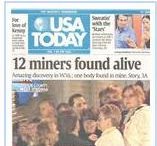 Broken News
Broken NewsRushing to Be First Means Getting It Wrong at WV Mine Disaster
What happened to attribution, confirmation, using trusted & reliable sources?
You can put the blame it on the wolf pack mentality/media circus that took over in Upsher County, West Virginia, but the miscommunication of 12 trapped coal miners found alive when indeed only one survived is a telling symptom of the breakdown in ethical journalism in the wake of live, cable-driven coverage of such events. The media frenzy clearly demonstrates what can go wrong when emotions rule reporters, producers and editors.
In the heat of the moment of trying to break news and serve the master of  “immediacy,” CNN’s Anderson Cooper and other broadcast outlets were just as culpable of adding to the pain. Most of the journalists failed to seriously question the “unofficial” information they were putting on live broadcasts. They failed to approach the rejoicing cautiously.
“immediacy,” CNN’s Anderson Cooper and other broadcast outlets were just as culpable of adding to the pain. Most of the journalists failed to seriously question the “unofficial” information they were putting on live broadcasts. They failed to approach the rejoicing cautiously. Journalists failed to nail down official confirmation. They failed to seek out the facts through multiple, trusted sources. Instead the professional journalists were lead around by emotional reaction from locals residents reconstructing their reality from what they heard passed around from second and third hand sources.
Journalists failed to nail down official confirmation. They failed to seek out the facts through multiple, trusted sources. Instead the professional journalists were lead around by emotional reaction from locals residents reconstructing their reality from what they heard passed around from second and third hand sources.
According to Editor & Publisher, "It's one of the most disturbing and disgraceful media performances of this type in recent years," as newspapers published headlines of “12 Alive” it clearly demonstrated how dedication to truth and fact finding was shoved aside for breaking a story based on hearsay.
"Journalists -- whether working in the field or in the newsroom -- should be professionally skeptical. Journalists should push constantly the "what if?" button. "What if that information isn't true?" "What if the source is wrong?" That professional skepticism is part of a vigorous checks and balances process that debunks rumors, reveals false assumptions and clarifies misconceptions. Ideally, professional skepticism produces high-quality, believable reports," writes Poynter Institute's Bob Steel. While newspapers could quickly repair the headline and coverage snafus online, USA Today and other papers sent out second runs to replace their hardcopy mistakes. USA Today’s original story also veiled attribution to an unnamed source in the governor’s office is suspect of fabrication as West Virginia Governor Joe Manchin refuted the attribution to Matt Lauer who was bigfooting the story for the Today show.
While newspapers could quickly repair the headline and coverage snafus online, USA Today and other papers sent out second runs to replace their hardcopy mistakes. USA Today’s original story also veiled attribution to an unnamed source in the governor’s office is suspect of fabrication as West Virginia Governor Joe Manchin refuted the attribution to Matt Lauer who was bigfooting the story for the Today show.
Washington Post media critic Howard Kurtz agrees that the media botched the story. He faults the journalists getting caught up as part of the story. "You don't broadcast or publish until it's absolutely nailed down, or at least you hedge the report six ways to Sunday. This was, quite simply, a media debacle, born of news organizations' feverish need to breathlessly report each development 30 seconds ahead of their competitors," writes Kurtz.
"You don't broadcast or publish until it's absolutely nailed down, or at least you hedge the report six ways to Sunday. This was, quite simply, a media debacle, born of news organizations' feverish need to breathlessly report each development 30 seconds ahead of their competitors," writes Kurtz.
Journalists need to revisit the guidelines for the truth and attribution and take a critical look at their role in all that went wrong. While they've been eager to shine a spotlight on someone to blame as they question mine officials about how this communication breakdown occurred , they've conveniently forgotten to shine that same light on their own behavior.
Reaction & criticism from the WC community:
- Titan Radio News Director Amanda Hauger addressed the situation in her BC Capstone Blog.
- Westminster Economics & Business Instructor Walt Dunlavey (he taught the Communication Law class last semester) responded to my posting with the following in an e-mail: "TV news shows, particularly cable TV news shows, are nothing but super market tabloids...one step shy of Jerry Springer."